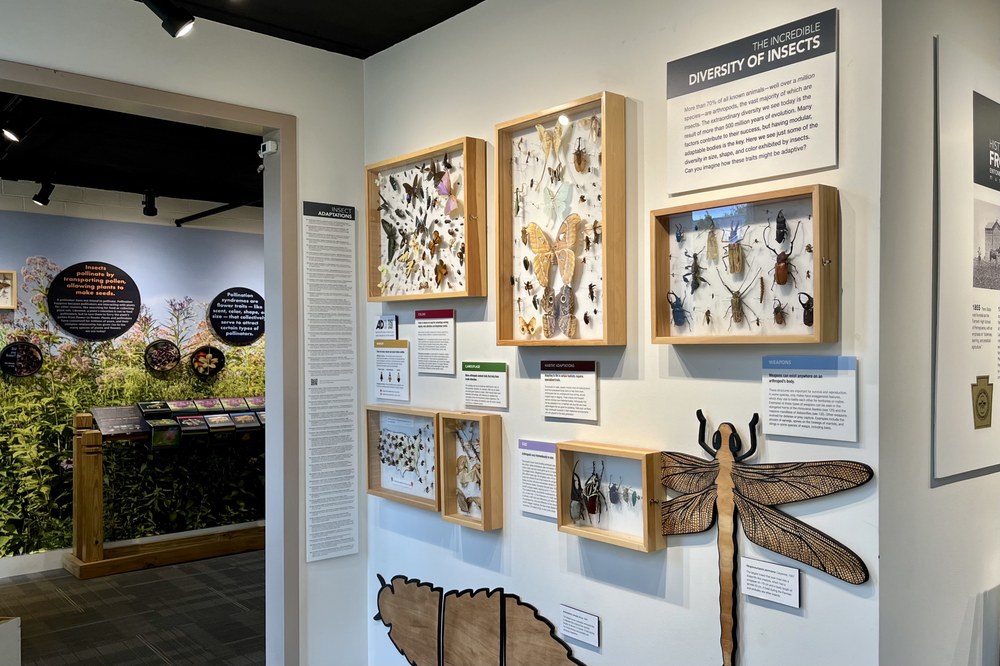This exhibit features some of our most compelling specimens, with insects of many shapes, sizes, and colors. Biological context is provided for many of these incredible traits.

The Diversity of Insects exhibit at the museum
More than 70% of all known animals—well over a million species—are arthropods, the vast majority of which are insects. The extraordinary diversity we see today is the result of more than 500 million years of evolution. Many factors contribute to their success, but having modular, adaptable bodies is the key. Here we see just some of the diversity in size, shape, and color exhibited by insects. Some topics covered include:
Colors
Effective camouflage, warnings and other signals rely on producing a variety of colors. Insect colors are produced by structural features and pigments. Colors produced through structure depend on precise patterning of a surface that scatters or reflects different wavelengths of light. At certain angles, lightwaves can magnify one another and cause brighter and more vibrant colors than those produced by pigments. Pigments are the other source of color, and are molecules that are usually deposited in the cuticle. Common pigments include pterins (yellow, orange, red), ommochromes (red, brown), carotenoids (red, orange, yellow), and melanins (black, brown)
Camouflage
Many arthropods evolved traits that help them evade detection. This strategy can be as simple as matching the color of the substrate. Katydids, for example, often live on plants and have green bodies to match. Other insects have more elaborate camouflage, with disguises so detailed they accurately mimic the structures of other organisms. The insects in this display, for example, look like sticks, leaves, and thorns of different plants.
Size
Arthropods vary tremendously in size. The largest known land-dwelling arthropod was a millipede-like critter called Arthropleura. It lived 300 million years ago and could grow up to 2.5 meters long. The largest insect, Meganeuropsis permiana, lived about 285 million years ago. Its wingspan was >70 cm and its body was almost 43 cm long! Insects do not grow that large today, but they still show remarkable variation in body size. The Hercules beetle, Dynastes hercules, is the world's longest beetle, reaching up to 17.5 cm in length. The smallest beetle, Scydosella musawasensis, is only 0.03 cm, or less than 1/3 the thickness of a credit card. That is almost a 600-fold size difference, just within beetles! For perspective, that size difference is like comparing the world’s largest mammal, the blue whale (Balaenoptera musculus, 25 meters long), to your pinky finger.
Weapons
Weapons can exist anywhere on an arthropod's body. These structures are important for survival and reproduction. In some species, only males have exaggerated features, which they use to battle each other for territories or mates. Examples of these types of weapons can be seen in the elongated horns of the rhinoceros beetles and the massive mandibles of dobsonflies. Other weapons evolved for defense or prey capture. Examples include the pincers of earwigs, spines on the forelegs of mantids, and stings in some species of wasps, including bees.
Habitat adaptations
Adapting to life in certain habitats requires specialized traits. To succeed in water, aquatic insects must be hydrodynamic and have specialized body parts to help them swim. Arthropods that live underground have strong, shovel-shaped legs for digging. Those insects that frequent narrow crevices have flattened bodies. Arthropods that live as parasites in fur or feathers are also flat and have appendages that are good for grabbing. Traits such as these help individuals succeed in their respective environments and are passed to the next generation.
The Frost Entomological Museum
Hours: Monday-Friday 10am-4pm
The Frost Entomological Museum
Hours: Monday-Friday 10am-4pm

